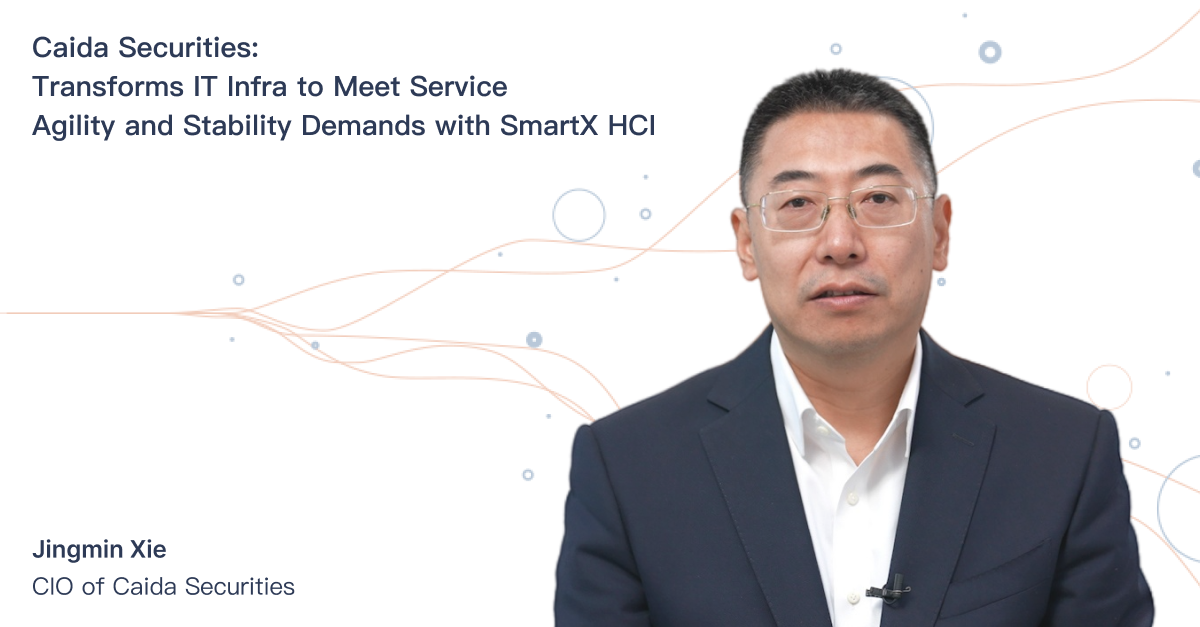As a leading securities company in China, Caida Securities has always insisted on empowering its business with innovative technologies. Notably, in recent years, Caida Securities has maintained its position at the forefront of digital transformation by transforming its IT infrastructure with SmartX HCI, catering to the ever-evolving demands of business agility and stability.
In this interview, Jingmin Xie, CIO of Caida Securities, sheds light on the remarkable progress achieved by the company in IT modernization.
Click here to watch the interview.
The following is the transcript of the interview.
Hello everyone! I’m Jingmin Xie, the CIO of Caida Securities.
Following the trend of digital transformation, Caida also focuses on the integration and mutual promotion of business and technology.
In the future, it can be foreseen that as digital transformation moves on, securities companies may evolve into technology-driven companies or a new type of technology company. Last year, our company also established a fin-tech department to empower businesses with financial technologies.
In fact, as the company emphasizes the development of various business lines, it raises new requirements for IT infrastructure. Traditionally, our requirement for IT infrastructure is stability, which means it should ensure the entire center’s security and stability, and provide functional support for various business lines.
As business services have moved online and become diversified, they should be able to adapt to agile development. Accordingly, the construction pattern of IT infrastructure has changed from a project-based mode to a capacity-based mode, which has resulted in the entire transformation of IT infrastructure architecture.
It is a natural IT modernization process in the industry, with an evolution that started from centralized architecture to virtualization, to HCI, and to the cloud. This process matches business development.
In order to better support business development, our company has built a large number of HCI clusters, which provide elastic, stable, and secure support to our business services. At present, securities companies, including us, primarily use HCI as our IT infrastructure.
HCI has various benefits such as its distributed architecture. And most importantly, it’s a lightweight and cloudified platform that is well-suited for the securities company’s service development.
As a securities company, we do not have a particularly large IT system, typically only having a few thousand servers or fewer, like, one or two thousand servers. Using a cloud platform to meet this computing demand still requires a large IT infrastructure, which is not an economical choice for us.
We want to select a smaller and more lightweight platform that performs well in terms of disaster recovery and performance. As a distributed and simplified IT infrastructure, HCI can meet our requirements. Also, with HCI, our platform can smoothly and naturally evolve into a private cloud. That’s why we chose HCI.
However, among so many HCI vendors, why did we choose SmartX?
Our main consideration was that SmartX is an outstanding and representative vendor in the entire industry.
Its HCI product also shows outstanding performance. In the early stages, we conducted a lot of POC testing with many HCI vendors, and it is worth noting that SmartX showed excellent performance in these tests. Traditionally, we used a centralized storage architecture with flash memory. But under SmartX HCI, the I/O performance is far superior to our original IT infrastructure.
In addition to SmartX’s leading technology, what impressed me the most was SmartX engineers’ professional skills and sincere attitude. They proposed appropriate solutions not only based on our technologies but also considered the overall deployment of securities company technologies. They gave us very good advice and suggestions concerning professional problems.
In addition, there is one characteristic of securities companies’ IT deployment; generally, in order to ensure the stability of the system, deployment usually takes place during holidays and at night. SmartX IT professionals did not complain about the hard work and could work well with our company under this harsh condition. Their dedication also greatly impressed us.
Our company began working with SmartX in 2019. After gradual construction, we have moved almost all of our systems to HCI platform except for the core database. Especially in the disaster recovery server room, we have already built a small-scale private cloud based on HCI, supporting systems including the core trading system and online trading system.
As a securities company, we have dozens of systems related to trading, and we have completely moved all of these systems to HCI.
Our current IT construction model has transitioned from the traditional project-based mode to a capacity-based one. At the beginning of the year, we’d consider the annual capacity needs of the entire system.
After completing the construction of the entire system, we can quickly respond to new business requirements and significantly shorten the construction cycle. The original project construction was calculated on a monthly basis, but through this technology, we have shortened the time to a daily or hourly basis.
The securities industry has very rapid business changes, which requires fast-paced IT construction. Especially this year, with the implementation of the registration system and our company’s needs of establishing new apps, a large number of devices need to be invested. We can provide hundreds of machines in just one day, providing a stable IT infrastructure for these business systems and reducing construction time and cycle.
Besides, we’ve established branch offices and R&D centers in Shanghai and Shenzhen. The construction of an on-premise cloud and its integration with the existing cloud is one of our new requirements. And as business demands increase, we can discuss and work with SmartX on some new areas.

